Menu

Partnerships in renewable energy are very effective. They are more likely to succeed and do so faster. Combining nature’s force with suitable renewable energy partnerships is key. This mix drives growth and sparks new ideas.
Recent figures from Partner Hacker highlight the huge advantages of these alliances. They open doors to unique growth chances and guide innovation towards a sustainable future.
Scot Forge is a great example of this. They team up with renewable energy OEMs to create exact, high-quality parts. These are crucial for solar, geothermal, wind, hydro, and biomass energy systems. Such efforts aid our environmental campaign significantly.
In our changing world, joining environmental energy partnerships is key for the renewable energy field. These partnerships help make big changes and bring new, needed solutions for the Earth. The CLIENT II funding programme shows this, helping with research projects across over 30 countries.
Working together in the renewable energy sector has many pluses. These alliances make it easier and faster to close deals, and they give a stronger, louder voice. They also help save money and boost trust. Partnerships lead to quick and high-quality work, which is very important for the power and economy.
Renewable energy partnerships show their worth in global efforts. Germany, for example, has joined forces with the US, Canada, and others since 2016. They work on green hydrogen, offshore wind, and vehicles that don’t make pollution. Also, projects like the “EU-Korea Green Partnership” help South Korea cut its shipping emissions.
Moreover, financial perks like the US Inflation Reduction Act (IRA) and the EU’s Critical Raw Materials Act (CRMA) boost cooperation in renewable energy and electric cars. By sharing what they know and have, partners help hit climate goals worldwide. This shows the crucial part partnerships play in bringing fresh ideas to renewable energy.
Sustainable energy collaborations are key for a greener future. They mean finding the best partners and building trust. This way, energy alliances can work towards being more eco-friendly. General Motors is leading by example, aligning their plans with green goals.
Finding partners with different strengths is vital for green energy projects to work. General Motors, for instance, wants all U.S. sites powered by renewable energy by 2025. This goal shows how important it is to work with partners who also want to go green. They work with groups like the Clean Energy Buyers Alliance to make their plans happen.
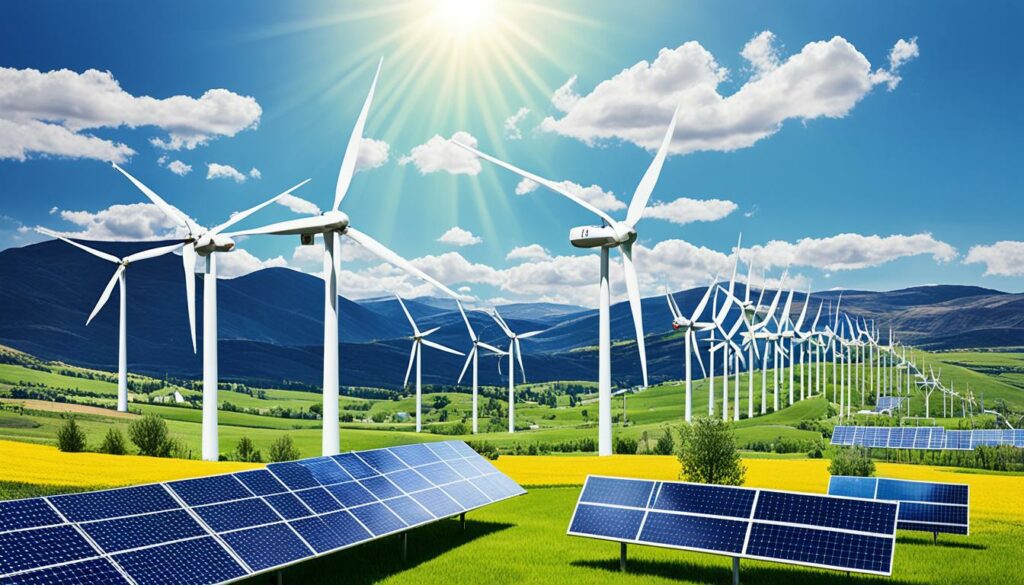
Creating local partnerships and investing in green energy near sites is key. This approach lowers emissions and helps local areas. Working with the NREL’s C2C program, General Motors gets technical support and funding. This support, around $3,500,000 for each new partnership, boosts local clean energy efforts.
Trust is the heart of green energy work. It grows with open actions and shared goals. General Motors supports the Emissions First Partnership to help set better accounting standards. Their renewable energy strategy, covering efficiency and policy, also builds trust.
Being clear builds strong partnerships. General Motors and Scot Forge show how trust helps meet energy needs. NREL’s C2C gives communities direct funding to better manage their energy. This support makes for a more open and helpful network.
Looking at successful green energy partnerships shows us the power of working together. These stories help us see how leaders in the field join forces. They achieve big goals in green technology and infrastructure.
Societé Générale gave ReNew Power in India a USD 1.2 billion green loan. It helped make 900 megawatts of wind power, 400 megawatts of solar, and a 100-megawatt-hour battery. This boosted sustainable energy development significantly.
Standard Chartered financed a floating solar plant in Indonesia that powers 50,000 homes. It cuts 214,000 tonnes of CO2 each year. This is a great example of how working together can make large-scale green projects happen. Also, Mizuho Bank’s investment in MCi Carbon supports cleaner industrial ways, showing the value of funding innovative eco projects.
The H2 Green Steel project got EUR 1.5 billion for Europe’s first green steel plant. It aims to slash CO2 by 95% compared to normal steelmakers. This shows how vital money and teamwork are in changing big industries to be greener.
Also, the success of a solar project by Alliance Manufacturing, returning investments in five years, shows sustainability can be good for business. Companies like American Family Insurance and Briggs & Stratton cut power use and costs through smart alliances. These examples teach us strategies for success in green energy partnerships.
Joint ventures (JVs) are becoming ever more popular for green energy projects. They bring together the power of different companies to make progress. Many big groups in the green energy field today involve both old oil and gas giants and new green businesses. By combining different skills and ways of thinking, they come up with fresh ideas and solutions which are key for being innovative in green energy.
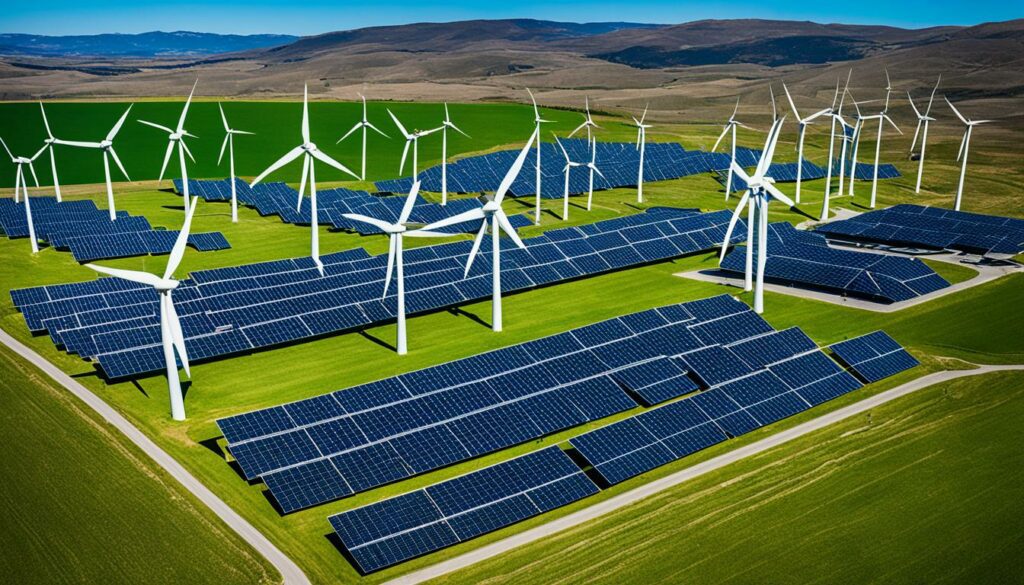
Green projects need new tech and a lot of money. To tackle these, government-backed groups join with private firms. This way, they share their money and know-how. This boosts their chance of getting funding, which can reach up to 1.5 million dollars. Remember, important dates are coming up: July 8, 2024, for summaries, and September 9, 2024, for detailed plans. They’ll decide who gets the money by November 2024.
But, not everything is smooth in working together. Sometimes, disagreements happen because everyone isn’t clear about who does what and who’s responsible if things go wrong. These arguments can slow down the work. Another issue is if one partner is much richer than the others. This can make deciding on and getting money harder.
Still, joint ventures are a key place for big ideas in green energy. When people from different backgrounds work together, they come up with creative solutions. Because of this, when companies work with government bodies, their combined effort can lead to unusual and very effective results. They can make more progress than if they were working on their own.
| Aspect | Impact |
|---|---|
| Popularity | Increasing among oil and gas majors |
| Project Funding | Up to 1.5 million dollars |
| Key Deadlines | Executive Summary: July 8, 2024 Full Proposal: September 9, 2024 |
| Disputes | Unclear risk allocation and scope of work |
| Partnerships | State-owned entities and private companies |
For any questions or more info, here are some contacts you can call:
Clean energy partnerships are key to being more efficient by sharing resources and knowledge. They help save money, benefit the environment, and boost the economy. By working together, companies can make big strides in being efficient and green.
In these partnerships, organisations use shared resources for financial and technical help. For example, through the NREL’s C2C scheme, each group gets up to $500,000 for subcontracts and $3,500,000 for technical help from national labs. Various groups, from governments to local charities, join, making sure all kinds of energy problems are tackled.
Working together makes operations run smoother. The model with Golden Valley Electric Association in Alaska stands out. It offers tips on improving how renewable energy is used. NREL gives broad technical support on green energy, transport, and energy safety. This teamwork is pushing for cleaner, more reliable, and fair energy, benefitting everyone involved.
Working together on renewable energy is key in fighting big environmental issues. The Global Climate Action Partnership involves 120 countries. It shows how working together can create low-emission and net-zero economies.
The Clean Energy Solutions Center gives help with policies and money. It has web training and clean energy reports for people to use.
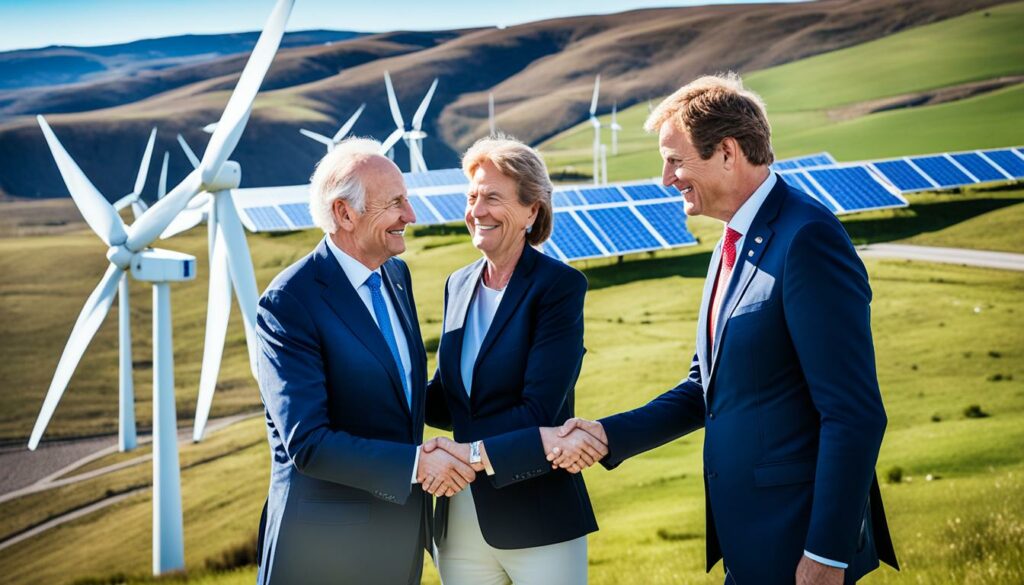
The 21st Century Power Partnership teams up with several countries including Brazil and China. They are focusing on changing the way power is made. Other groups like the Electric Vehicles Initiative and the Hydrogen Initiative push for clean vehicles and hydrogen use. This shows how important renewable energy cooperation is for a cleaner energy future.
More efforts like the NICE Future initiative and the Carbon Capture plan aim to cut CO2. They focus on new ideas to make these changes happen. The Net-Zero Industries work on making big industries cleaner. These efforts show how working together can really change things.
One key partnership is between USAID and NREL. It helps emerging countries switch to clean energy. The Net Zero World Initiative shows the big effort it takes to reach net-zero worldwide.
To sum it up, these many partnerships underline how important it is to work together on renewable energy. Through these efforts, we can make a real difference and move towards a green future.
The world of sustainable energy is always changing, shaped a lot by rules and laws. The help from governments is key to the success of green power plans and fighting the rules that get in the way.
Backing from governments is vital for green energy to grow. For example, the Global Climate Action Partnership shows how rules can help green plans work. This teamwork from 120 countries and 450 groups helps build economies that don’t add to climate change. The Clean Energy Solutions Center also gives help with the money and rules for free, making it easier for everyone to learn and make good choices.
Even with strong government help, there are still big problems with the rules. The plan for ocean ships to have zero emissions by 2030 shows how tough the rules can be. And making clean hydrogen is much more expensive than dirty hydrogen. These issues show the hard road to making some industries cleaner. But places like the National Renewable Energy Laboratory are working hard, helping the US and other countries figure out better power and energy ways, especially for the growing countries.
Partnerships like with IRENA are working to help solve these issues. They have specific groups for advice and support. IRENA also holds special events to get more investment in clean energy. These efforts spread knowledge and support to fix rules and policy problems.
Working with companies and other groups is crucial to push through hard rules. They want to make strict rules that help, not hinder. By doing this, we can make a better, greener future for everyone.
In environmental energy partnerships, involving the local community is vital. Their support builds trust and ensures the success of projects. For example, Dominion Energy’s foundation has given over $15 million to local groups in Hampton Roads. This support has boosted renewable energy and social justice efforts.
EnergyShare, since 2012, has helped over 34,700 people in Hampton Roads with nearly $12 million. Such schemes show the importance of working closely with communities. They help everyone see the positive impact of renewable energy projects.
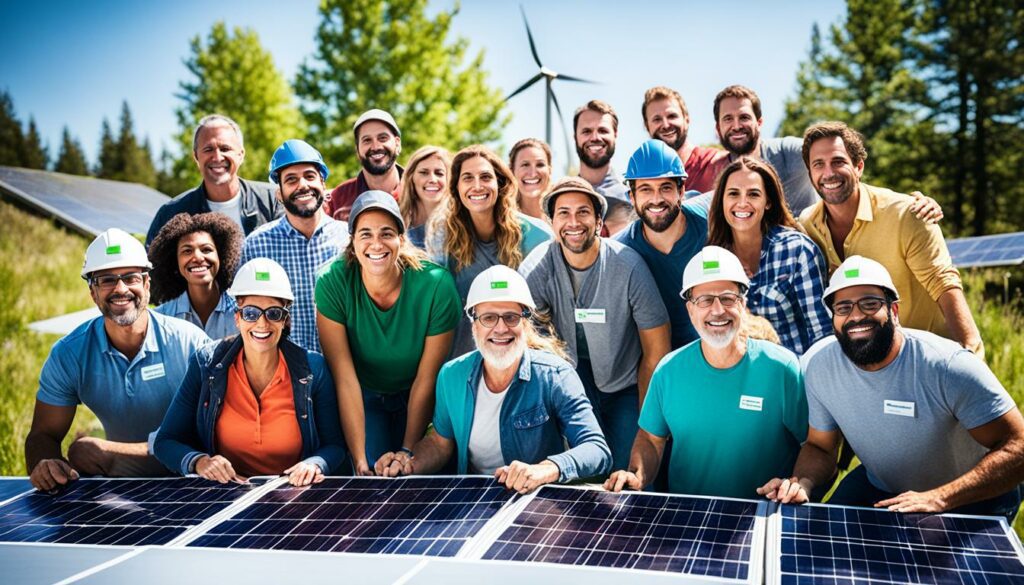
Through Dominion Energy’s $35 million pledge in 2020, including $2.75 million each for Hampton University and Norfolk State, we see community-focused support’s power. This aid greatly benefits education and local growth.
Involving the community in new greenfield projects can boost the local economy and encourage local participation. Workshops and seminars are key. They educate the public about renewable energy’s benefits and ensure community understanding and support.
Community engagement is essential in environmental energy partnerships. It is the foundation for creating sustainable, strong communities. When everyone pitches in, these initiatives see long-term success. Keeping the community informed and involved from the start is critical. It helps prevent opposition and builds strong local backing over time.
In the world of renewable energy, partnerships are key in pushing forward with new technology. Companies like General Motors show how important these alliances are. They aim to rely on 100% renewable electricity worldwide by 2035.
By the end of 2025, they will ensure all their U.S. sites use renewable electricity. This demonstrates the power of partnerships in making big changes.
Research and development are vital in renewable energy. Partnerships help combine efforts to find new tech solutions. General Motors and others work together to boost energy efficiency and create reliable renewable energy systems. They also push for policies that help the planet.
High-tech solutions are essential in the renewable energy field. One example is Virtual Power Plant technology. It links up various energy sources like solar power, battery storage, and electric cars. This approach makes energy services more reliable and resilient.
Scot Forge is leading in making advanced parts for renewable energy. Their work highlights how important partnerships are. They help in making new, cutting-edge technology.
Working with groups like the Clean Energy Buyers Alliance and the VP3 helps move renewable energy forward fast. This shows the crucial role partnerships play in the renewable energy sector.
Long-term success in renewable energy needs a clear vision and shared goals. For example, Procter & Gamble and ENGIE North America have partnered. With a solar project, they’ll provide P&G with over 530,000 MWh of renewable energy each year.
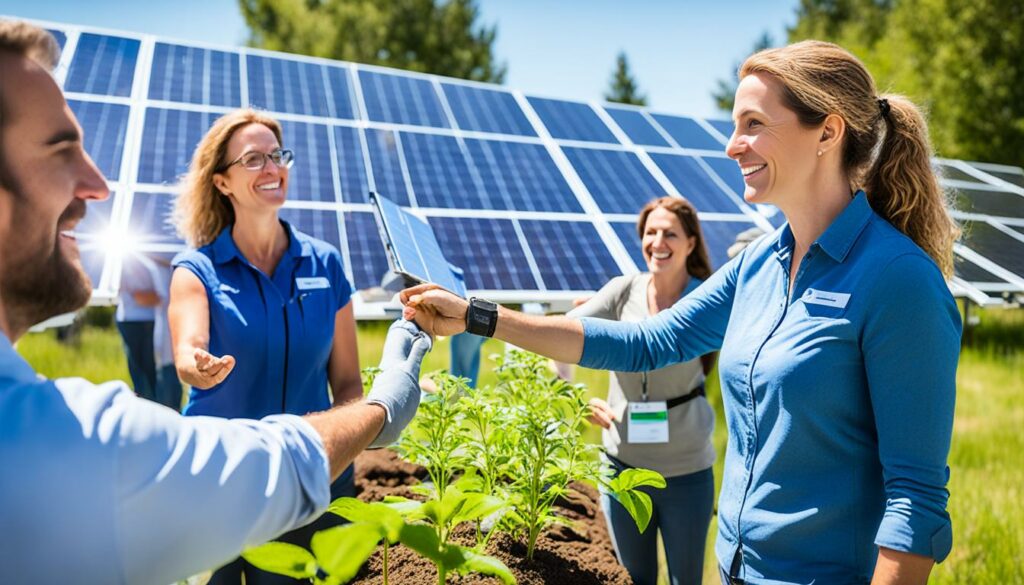
Their project in Texas will create energy for more than 50,000 homes a year. This means a big part of Cincinnati, Ohio, where P&G is based, could get green energy. It’s a great example of making a real impact through partnership.
P&G and ENGIE are working towards having zero net greenhouse gas emissions by 2040. This big aim shows how powerful shared goals are in long-term renewable energy partnerships.
In Texas, at Sun Valley, their solar project is helping the environment in a unique way. It uses local plants and even has 1,500 sheep to keep the land healthy. This teamwork shows the value of smart and sustainable partnerships.
“At the core of all successful renewable energy partnerships lies a strong commitment to a shared sustainable future,” says Chad Riley, the Director of Innovation & Strategic Partnerships at Nelnet.
Procter & Gamble is aiming to use 100% renewable energy by 2030. This tough goal shows their commitment to green partnerships. Since 2018, Nelnet helped with nearly $1 billion in solar projects in the U.S., highlighting the need for long-term teamwork in green energy.
| Company | Project Size (MW) | Annual Renewable Power (MWh) | Additional Benefits |
|---|---|---|---|
| Procter & Gamble & ENGIE | 200 MW | 530,000 | Supports natural ecosystem through vegetation management and pollinator aid. |
Big or small, renewable energy partnerships can make a difference. Onyx Renewable Partners have done various solar projects. A 6.2MW project in Arizona and work in Northern California help a lot with saving energy.
This kind of teamwork really makes sustainability happen. Scot Forge is a loyal partner, showing how important and effective long-term green relationships are in the business.
The world of renewable energy offers many chances for partnerships, especially in solar and wind power. These alliances help improve technology and expand into markets. They make renewable resources more available and efficient.
Working together in solar energy helps improve how solar panels work. It involves partnerships between governments, businesses, and non-profits. Take, for example, working with Scot Forge, which makes key parts for solar systems with great precision. This teamwork boosts innovation, shares knowledge, and trains new experts. All of this is key for a strong future in solar power.
Wind energy alliances are vital for the progress of wind power. They include teaming up with experts like Scot Forge to create top-notch wind turbine parts. These partnerships are supported by large businesses and programs that help start-ups. They provide new ideas and money. Also, there are helpful laws and benefits that encourage this teamwork. All these things help advance wind energy.
The table below shows different ways alliances are formed and what they do:
| Type of Alliance | Participants | Impact |
|---|---|---|
| Public-Private Partnerships (PPPs) | Government agencies, Private sector companies, Nonprofit organisations | Joint development and deployment of renewable energy projects |
| Industry-Academia Collaborations | Universities, Research Institutions, Private sector | Knowledge exchange, research collaboration, and talent development |
| Corporate Partnerships & Accelerator Programmes | Startups, Corporations | Access to industry expertise, mentorship, and funding opportunities |
| Investor Networks | Impact funds, Venture capital firms | Provision of capital for scaling renewable energy operations |
| Policy Incentives | Government, Policy Makers | Encouragement of investment in renewable energy technologies through renewable energy targets, feed-in tariffs, and tax incentives |
To sum up, building strong alliances in solar and wind energy is key. It speeds up tech progress and spreads benefits across the board. This helps grow the industry and supports a sustainable future.
Co-branded environmental campaigns bring together different brands to share a single, powerful message. They help reach a wider audience with a story that speaks to people. This way, the impact on consumers is stronger and clearer.

Joining forces, brands create a clear and strong message in these campaigns. Almost 70% of consumers today want to see how companies handle environmental issues. A shared voice makes brands’ environmental efforts and aims more easily understood.
Partnering up boosts the campaign’s outreach. Research shows that working together makes closing deals 53% more likely and speeds up the process by 46%. Take Taylor Stitch and Corkcicle, who saw big wins in their campaigns. They attracted new people and made a more significant impact on the environment.
Here’s a look at some of their big achievements:
| Brand | Metric | Statistic |
|---|---|---|
| Taylor Stitch | Revenue Increase Q1 2022 | 11% |
| Taylor Stitch | Year-to-Date ROI | 1,600% |
| Corkcicle | Revenue Increase | 10% |
| Corkcicle | ROAS Boost | 20% |
| Booktopia | Revenue Growth Year-on-Year | 38% |
| Booktopia | Clicks Boost | 90% |
These results clearly show the benefits of working on environmental campaigns together. They lead to more people getting involved and better involvement. In the end, teaming up helps companies improve their green messages. It also makes a bigger positive change thanks to a wide and thoughtful plan.
Partnerships are key in spreading knowledge about renewable energy globally. The National Renewable Energy Laboratory (NREL) works with 120 countries and 450 institutions through the Global Climate Action Partnership. This helps push forward ambitious climate aims all over.
NREL focuses on projects to help countries shift to clean energy. For example, they run the Clean Energy Solutions Center. It gives expert advice on policies and finances. Also, it provides online training and tools for creating clean energy policies. This mix of policy support and training is vital for countries to adopt green reforms.
Online learning is now a big part of how we educate about renewable energy. Groups like the Global Power System Transformation Consortium and the Clean Energy Ministerial help with online platforms. These let people learn from research and each other. The aim is to make renewable energy education available to many.
NREL runs hands-on workshops, too, like those for electric vehicles and hydrogen use. These workshops get people directly involved, helping them learn about sustainable tech and energy safety first-hand. By working with local groups and schools, these workshops boost real-world skills and community participation.
The Nuclear Innovation: Clean Energy (NICE) Future pushes for fairness and economy through its educational workshops. These workshops aim to give a complete idea of nuclear technology for clean energy. By using interactive methods, these workshops make educational efforts more powerful. They help people actively join in on boosting renewable energy.
Events are key for creating strong renewable energy partnerships. They allow for communication and working together. Michelle knows this from managing many events. Workshops and Q&A sessions let companies share their goals and connect with others. They often highlight real benefits, like helping 493 million people get power from off-grid solar since 2012.
Without events, making renewable energy partnerships in Africa might be hard. By 2030, there could still be nearly 600 million without electricity. Events support efforts to reach these people. For instance, by 2030, off-grid solar could bring power to 464 million sub-Saharan Africans. That’s a big step forward.

But, some places needing electricity are not seen as profitable enough. These areas are home to 89% of people who lack electricity. Events that highlight this issue can attract funds and advice to these often-forgotten markets. Plus, if governments offer support, like subsidies, it can really help renewable energy grow.
At these events, training is crucial for running renewable energy systems. Partnerships formed at these events can target where power is needed most. They can make businesses more efficient by lowering energy costs. This also improves their reputation.
Groups like the International Renewable Energy Agency hold valuable workshops. They promote sharing technology and building stronger partnerships. Such efforts aid in funding renewable energy projects. Major conferences, like RESEE2023, are crucial for sharing the latest in clean energy and boosting energy efficiency.
The path to successful renewable energy partnerships faces several hurdles. These hurdles stem from the many different sectors these partnerships span. For example, Michelle’s journey highlights the complex issues in these partnerships. This shows we need specific plans to overcome each challenge.
The C2C program stands out in addressing these hurdles. It provides big financial support. This includes up to $500,000 in funding for subcontracting and $3,500,000 in technical aid. C2C works with both local councils and community groups on important energy issues. These include renewable energy, green transport, and fairness.
A great example is C2C teaming up with a power company in Alaska. They made a custom solution to make moving to cleaner energy safer and easier. This effort supports local groups with money and experts to get the job done. It’s a model for other places aiming to become greener.
The future of renewable energy looks bright. The market for microgrids is set to grow a lot by 2032. This shows a big demand for more sustainable energy options. Home solar is expected to increase, while wind power could get cheaper by 2035. These changes prove the renewable energy sector is evolving fast.
Scot Forge excels in handling sudden challenges. Their quick response ensures that work on renewable projects keeps going smoothly. They teach us that being able to change fast is crucial. This keeps renewable efforts moving forward without major delays.
In conclusion, dealing with the issues in renewable partnerships asks for a detailed plan. Teaching, working together, and being ready for surprises are key. By using these methods, we can build a stronger, more eco-friendly future.
Renewable energy partnerships succeed when all parties benefit, share resources, and fight environmental issues together. On November 16, 2023, the United States, Australia, Japan, and other partners from the IPEF signed the Clean Economy Agreement. It aims to move towards a zero-emissions economy, keeping global temperatures from rising over 1.5 degrees Celsius.
This deal focuses on working together on clean tech, cars with no emissions, and eco-friendly solutions for farming, forests, water, and the seas. It’s not just governments involved. Even groups like the U.S. Department of Commerce and the U.S. International Development Finance Corporation are taking part. They’ve set up funds to help with climate-friendly projects in IPEF countries by attracting private investment.
Partnerships like these bet on renewable sources making up 60% of our power by 2030. We’re already seeing how wind and solar are costing less than fossil fuels in many places. This not only helps the planet but also creates chances for growth in places like Latin America, the Caribbean, and Africa. Efforts by organizations such as Scot Forge highlight how teamwork and common values are key to achieving our renewable energy aims.
Getting involved in renewable energy partnerships has many pluses. It improves the odds and speeds of making deals. It also boosts your voice, extends your reach, saves shared costs, and builds trust and truth. This is key for new ideas and opportunities for growth.
Renewable energy partnerships change the game by creating smart alliances and fresh solutions. They lead to better technology, shared wins, and smoother operations. These partnerships are vital for a greener future in energy.
To make sustainable energy work, focus on finding the right partners. Trust and clear communication are essential. Activities like creating joint educational content and forming ventures are key. They help spread a strong and trustworthy message for lasting success.
For successful green alliances, precision and timely delivery are crucial. A great example is Scot Forge’s work with green energy makers. They’ve made strong energy structures for solar, geothermal, wind, hydro, and biomass.
Green ventures spark new ideas by mixing different skills. They push new tech, improve old ones, and help green energy grow. This leads to more sustainable ways to power our world.
Pooling resources and skills boost partners’ power in clean energy. It makes things work better, cuts costs, and launches more powerful projects. This way, partners can make the biggest positive impact in the industry.
Worldwide, big plans are being made to tackle environmental issues. These plans use big partnerships to make real changes. They help face legal challenges and get government help for a sustainable future.
Rules and laws affect these partnerships a lot. They offer chances for government support but also bring tough rules. To succeed, partners need to really understand what’s needed. They must work together to face these challenges and thrive.
Getting the community on board helps these partnerships succeed. Through events and education, community cooperation can drive these projects. This way, more people will support and use green practices.
Renewable power pioneers new tech by working together on research and development. Partners share ideas and resources, making better and greener technologies. This is how the industry keeps moving forward.
To last long, green partnerships need shared goals and steady teamwork. They’re built on trust, honesty, and a joint passion for a green future. This strong foundation leads these partnerships to success.
In sectors like solar and wind power, alliances focus on tech improvements and joint success. They work to be more efficient, inventive, and influential. By putting together what each has to offer, they make a bigger impact.
Joint green campaigns enhance your message for a wider audience. They boost your impact and are key for big environmental changes. Working together this way spreads the word further and louder.
Green partnerships offer online lessons and hands-on workshops. These teach and inspire people to care for the environment. Making others more aware and knowledgeable is how these partnerships make a real difference.
Using events right can do a lot for green partnerships. They provide chances to talk, share ideas, and show your vision. By connecting with others and discussing plans, partnerships can do a lot more together.
Problems in green partnerships include understanding benefits, laws, and surprise issues. Fixing these needs learning, teamwork, and smart working models. This way, partnerships can overcome any challenge stronger.